



































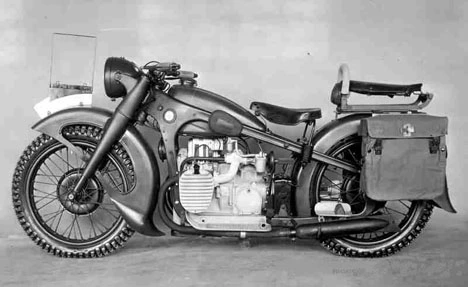
BMW's R12 from the 1930s
宝马R12从20世纪30年代
BMW's R12 from the 1930s
宝马R12从20世纪30年代
Harley-Davidson
had been building motorcycles since 1906. BMW got a much later start, around 1921; but by the time World War II rolled around, BMW's design & engineering was already world-class.
哈雷戴维森
自1906年以来一直在制造摩托车。宝马的起步要晚得多,大约在1921年;但到第二次世界大战爆发时,宝马的设计工程已经是世界一流的了。
In the 1930s BMW had mastered the emerging production method of electric arc welding, and were able to create incredibly strong joints. This practice was borne of necessity; sidecars were popular in Germany, perhaps more popular than in the 'States, where Americans aspired to ride around in automobiles. Sidecars placed a lot of stress on a motorcycle frame. But in thrifty Germany, with one passenger in the sidecar and another behind the driver, a sidecar-equipped motorcycle was an economical way to transport three people. BMW made their frames strong enough to handle that load.
在20世纪30年代,宝马已经掌握了电弧焊的新兴生产方法,并能够创造出令人难以置信的强大接头。这种做法是必要的;边车在德国很受欢迎,也许比美国更受欢迎,美国人渴望乘坐汽车。侧车对摩托车车架施加了很大的压力。但在节俭的德国,一个乘客在边车,另一个在司机后面,一个配备边车的摩托车是一个经济的方式运送三个人。宝马使他们的框架足够强大,以处理负荷。
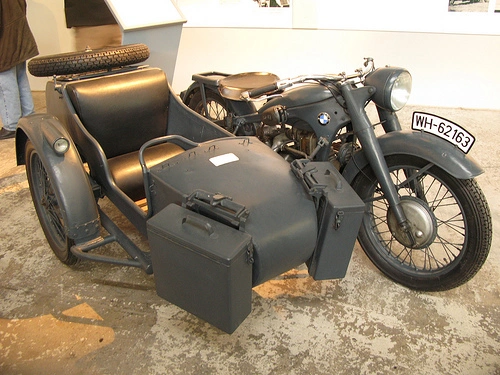
Another impressive feat of design and engineering was BMW's front forks. For comparison's sake, look at the top of the front fork on the Harley-Davidson WLA we discussed in the
last entry
:
另一个令人印象深刻的设计和工程壮举是宝马的前叉。为了比较起见,看看我们在
上一篇文章
中讨论的Harley-Davidson WLA前叉的顶部:
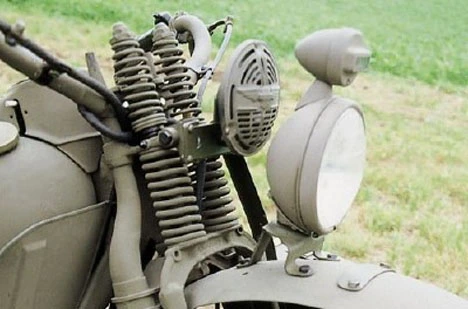
See how the design requires the shocks be exposed to the elements, sticking out of the top like that? In contrast, BMW perfected
telescoping
forks, which had the shocks on the inside:
看看设计要求减震器暴露在自然环境中,像那样伸出顶部?相比之下,宝马完善
了伸缩
叉,其中有内部的冲击:
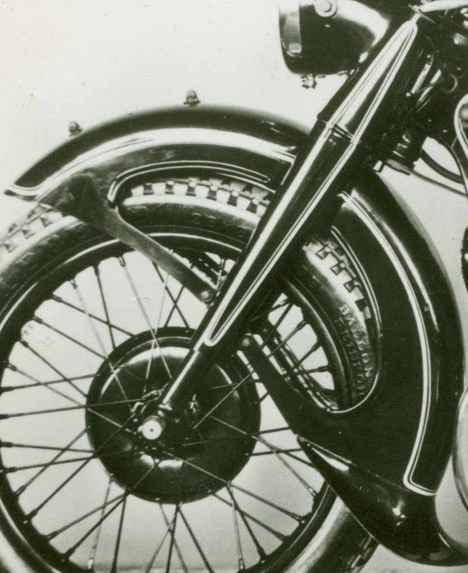
If we compare the forks of BMW's R12 side-by-side with the Harley WLA, the Harley looks primitive in comparison.
如果我们比较叉宝马的R12并排与哈雷WLA,哈雷看起来原始的比较。

It is true that the R12 mechanic would have to remove an additional housing to access the shocks for replacement or repair, but that was presumably a worthwhile trade-off for keeping sand, snow and ice out of the springs. And the bike had a reputation for being easy to work on; Georgia-based professional motorcycle restorer John Landstrom calls the R12 "probably the easiest to work on and most reliable of the pre-war BMWs...[it] has a very simple, basic layout that was designed for the military so they could be fixed in the field."In the video below, Landstrom discusses the design features of the R12, mostly from 3:35 to 6:15. You can also see that the Germans were able to add some offensive capabilities to the sidecar by mounting a machinegun on it.
诚然,R12机械师将不得不删除一个额外的住房,以访问更换或维修的冲击,但这大概是一个值得的权衡保持沙子,雪和冰的弹簧。这款自行车以易于维修而闻名;乔治亚州的专业摩托车修复师约翰·兰德斯特罗姆(John Landstrom)称R12“可能是战前最容易维修和最可靠的宝马车。[it]有一个非常简单的基本布局,是为军队设计的,这样他们就可以在战场上固定。在下面的视频中,Landstrom讨论了R12的设计特点,主要是从3:35到6:15。你还可以看到,德国人能够通过在边车上安装机关枪来增加一些进攻能力。
Sometime around 1941, BMW began producing an improved motorcycle at the German army's request. Their resultant R75 had a permanently-attached sidecar whose wheel was connected, via axle, to the motorcycle's rear wheel. The R75 thus effectively had two-wheel drive, which greatly improved the motorcycle's handling in adverse conditions. To simplify inventory and maintenance, all three wheels were designed to be interchangeable, and a spare was attached to the rear of each sidecar.
大约在1941年,宝马应德国军队的要求开始生产改进型摩托车。他们最终的R75有一个永久连接的边车,其车轮通过车轴连接到摩托车的后轮。因此,R75有效地实现了两轮驱动,大大改善了摩托车在恶劣条件下的操控性。为了简化库存和维护,所有三个轮子都被设计成可互换的,每个边车的后部都有一个备用的。
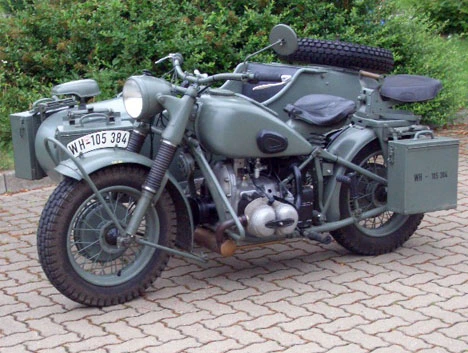
As you can see in the photo below, BMW engineers also updated the telescoping fork with an accordion-like rubber housing; they found the elastic material made a better seal to keep the sand out.
正如你在下面的照片中看到的,宝马的工程师还更新了伸缩叉与手风琴一样的橡胶外壳;他们发现弹性材料制成了一个更好的密封,以保持沙子。
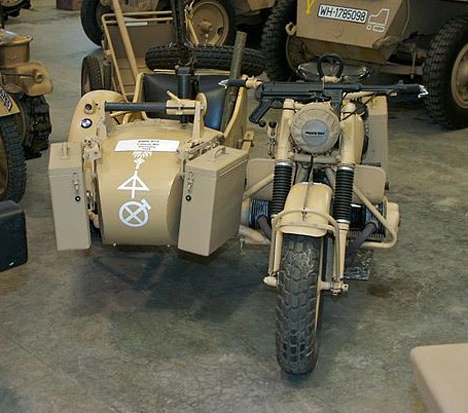
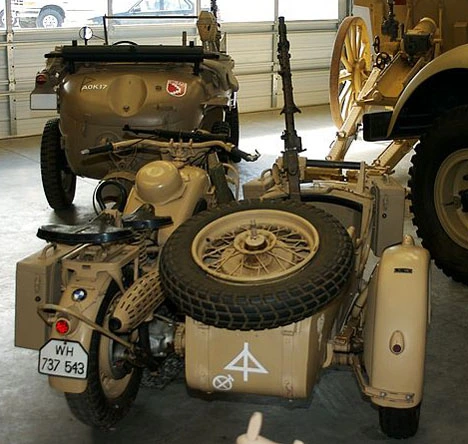
Loaded up with two Jerrycans on the sidecar, one on the bike's rear, an extra seat behind the driver and a freaking machinegun, the R75 made for a formidable and utilitarian vehicle capable of carrying three.
在边车上装了两个Jerrycan,一个在自行车的后面,一个额外的座位后面的司机和一个奇怪的机枪,R75是一个强大的和实用的车辆能够携带三个。
Both the R12 and the R75—and indeed, any motorcycle made by BMW until 1994—also incorporated another clever mechanical trick that Harley-Davidson had not been able to pull off: shaft drive. I'm not talking about the sidecar; I mean the rear wheel of the motorcycle was driven by a rotating shaft connected to a universal joint. In contrast, Harley's SLA, like most other motorcycles of the era, was chain-driven. As both the U.S. and Germany military would discover in the North African campaign, BMW's enclosed shaft was superior, in sandy conditions, to an exposed chain that grit could get inside of.
R12和R75--事实上,宝马在1994年之前生产的任何摩托车--都采用了另一种哈雷戴维森无法实现的巧妙机械技巧:轴驱动。我说的不是边车,我的意思是摩托车的后轮是由一个连接到万向节的旋转轴驱动的。相比之下,哈雷的SLA,像大多数其他摩托车的时代,是链驱动。正如美国和德国军方在北非战役中发现的那样,宝马的封闭轴在桑迪条件下比暴露在外的链条优越上级,沙砾可能会进入其中。
I should point out that in the 1930s and '40s, to an American engineer, shaft-drive and telescoping forks were something like the concept of laser pistols today; we can envision how they should work in theory, but we can't yet figure out how to make them. BMW had figured it out, and their advanced design and engineering was thus providing the German military with a material advantage.
我应该指出,在20世纪30年代和40年代,对于一位美国工程师来说,轴传动和伸缩叉就像今天的激光手枪一样;我们可以想象它们在理论上应该如何工作,但我们还不能弄清楚如何制造它们。宝马已经发现了这一点,他们先进的设计和工程因此为德国军方提供了物质优势。
However, as with
the tale of the Jerrycan
, at some point Allied troops captured a German R12 or R75 and sent it back home to be studied. Once the U.S. engineers had ripped the bike apart, converted the metric to Standard and reverse-engineered the manufacturing technology, Harley-Davidson was then tasked with producing a similar shaft-driven design. The results of their efforts, the Harley-Davidson XA, are below:
然而,就像
杰里坎的故事
一样,在某个时候,盟军部队捕获了德国R12或R75,并将其送回国内进行研究。一旦美国工程师将自行车拆开,将公制转换为标准,并对制造技术进行逆向工程,哈雷戴维森的任务就是生产类似的轴驱动设计。他们的努力成果,哈雷戴维森XA,如下:
As it worked out, just over 1,000 XA models were produced—and they never got to see the North African sands for which they were designed. Military bureaucracy, combined with an increasing Army reliance on jeeps, meant that the relatively few XAs produced were wastefully relegated to base duty on U.S. soil. Today the XA is a collector's item.
最终,只生产了1,000多个XA模型,但他们从来没有见过他们设计的北非沙漠。军事官僚主义,再加上陆军对吉普车的日益依赖,意味着生产的相对较少的XA被浪费地降级为美国本土的基地职责。今天,XA是一个收藏家的项目。
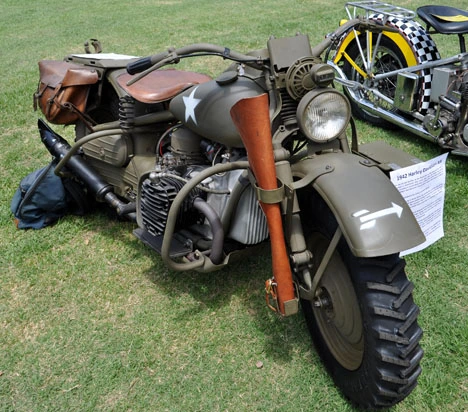
Did the XA getting the AX sound the death knell for military motorcycles? Not quite. Stay tuned.
XA获得AX是否敲响了军用摩托车的丧钟?不完全是别走开
Military Motorcycles:
»
Part 1: WWII and Harley-Davidson
»
Part 2: WWII and BMW
»
Part 3: The Modern-Day Decline
»
Part 4: Andy Keel's Motocrossboard as a Possible Alternative?
军用摩托车:
»
第一部分:二战和哈雷戴维森
»第二部分:二战和宝马
»
第三部分:现代衰落
»
第4部分:安迪基尔的越野摩托车作为一个可能的选择?




































